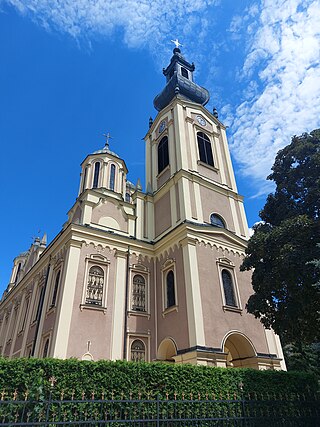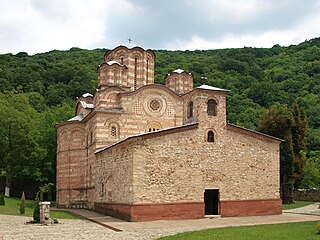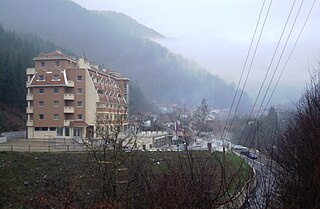
The Ljubostinja Monastery is a Serbian Orthodox monastery near Trstenik, Serbia. Located in the small mountain valley of the Ljubostinja river, the monastery is dedicated to the Holy Virgin.

Fudbalski klub Zemun is a Serbian professional football club based in Zemun, Belgrade, that competes in the Serbian League Belgrade.

The Cathedral Church of the Nativity of the Theotokos is the largest Serbian Orthodox church in Sarajevo and one of the largest in the Balkans. The cathedral is designated National Monument of Bosnia and Herzegovina by the KONS.

The Rača Monastery is a Serbian Orthodox monastery 7 km south of Bajina Bašta, Serbia. The monastery was built by Stefan Dragutin (1276-1282). The monastery became a place where Serbian rulers, nobles, and church dignitaries were buried. The monks translated texts from Ancient Greek, wrote histories, and copied manuscripts ; they translated and copied not only liturgical but scientific and literary works of the period.

The Church of the Holy Transfiguration is a Serbian Orthodox church in Novo Sarajevo, Sarajevo, Bosnia and Herzegovina.

Ravanica Monastery is a Serbian Orthodox monastery on Kučaj mountains near Senje, a village in Ćuprija municipality, in central Serbia. It was built in 1375–1377 as an endowment of prince Lazar of Serbia, who is buried there. The church is called the birthplace of the new artistic movement "Morava school", due to its architectural and artistic features. It is a blend of the Mount Athos and cross-in-square five-domed model that became standard in the time of King Milutin.

Naupara monastery is a Serbian Orthodox Christian monastery situated 30 km south of the town of Kruševac and about 190 km from Belgrade. The original building was completed in 1391 but was severely destroyed by Turks in 1454. It was not restored until 1835 when brothers Stojan Simić and Aleksa Simić took on the project. They offered the church a bell, sacred books, and other religious items upon its completion. Naupara is built in the Serbian architectural style of the Morava school and was constructed in the same style as the Lazarica Church. The paintings and iconostasis within the monastery date to the 19th century since the original frescos were ruined during the restoration. Today, Naupara is an active nunnery, with a small number of nuns who tend to the land.

The Church of Holy Apostles Peter and Paul, known as the Cave Church, is a Serbian Orthodox cave-church located on eastern slope of Mount Kopaonik near Lukovo, southern Serbia. it was built by the Serbian King Milutin in the 14th century and is dedicated to Saints Peter and Paul. It is part of the Monastery of St. Archangel Gabriel.

Gredetin is a village in the municipality of Aleksinac, Serbia. The Gredetin settlement is located on the 15 kilometers from the town of Aleksinac.

Lukovo is a village on the eastern slopes of Mount Kopaonik, in the municipality of Kuršumlija, in southern Serbia. It is a spa town of highest altitude in Serbia. According to the 2011 census, the village has a population of 275 inhabitants.

Lukovo is a village in the municipality of Boljevac, Serbia. According to the 2002 census, the village has a population of 704 people.
Lukovo is a village in the municipality of Raška, Serbia. According to the 2002 census, the village has a population of 38 people.
Majdevo is a village in the municipality of Kruševac, Serbia. According to the 2002 census, the village has a population of 491 people. The village's history includes the Minić villa, the old school and church of Sveta Petka. King Alexander I Karadjordjevic visited the village a number of times. The village is also notable for the first Serbian ethno film.
Lukovo is a village in Struga Municipality, in North Macedonia. It was a seat of Lukovo Municipality until 2004.
Lukovo (Svrljig) is a village in the municipality of Svrljig, Serbia. According to the 2002 census, the village has a population of 277 people.
Dobroselica is a village in the municipality of Čajetina, western Serbia. According to the 2011 census, the village has a population of 367 people.

The Stuplje Monastery is a Serbian Orthodox monastery dedicated to Archangel Michael and located in the village of Gornji Vijačani near the town of Čelinac in north-western Republika Srpska, Bosnia and Herzegovina. Folk tradition attributes the establishment of Stuplje to King Dragutin, a member of the Serbian Nemanjić dynasty, as is the case with other Serbian monasteries in northern Bosnia. The earliest mention of Stuplje is found in a chronicle dated to the second half of the 15th century. The monastery was probably founded before 1450, and thus before the Ottoman conquest of the Kingdom of Bosnia in 1463. This conquest did not include north-western Bosnia, which then became part of the Kingdom of Hungary, to be conquered by the Ottomans in 1527 and 1528. During the 17th century, the monks of Stuplje were active in transcribing religious books. At some point during the Great Turkish War (1683–1699), the monastery was burned down by the Ottomans. Surviving monks fled north across the Sava River and found refuge in the Orahovica Monastery in Slavonia. They brought with them a number of their manuscript books, which thus became part of the Orahovica library.

Nenad Jezdić is a Serbian actor. He appeared in more than fifty films since 1993, such as Barking at the Stars (1998), The Dagger (1999), Frozen Stiff (2002), Black Gruya and the Stone of Wisdom (2007).

Putevi Užice is a Serbian construction company headquartered in Užice, Serbia.

All Serbian Saints Serbian Orthodox Church is a Serbian Orthodox church located in Mississauga, Ontario, Canada. It is dedicated to all the Serbian saints.
















